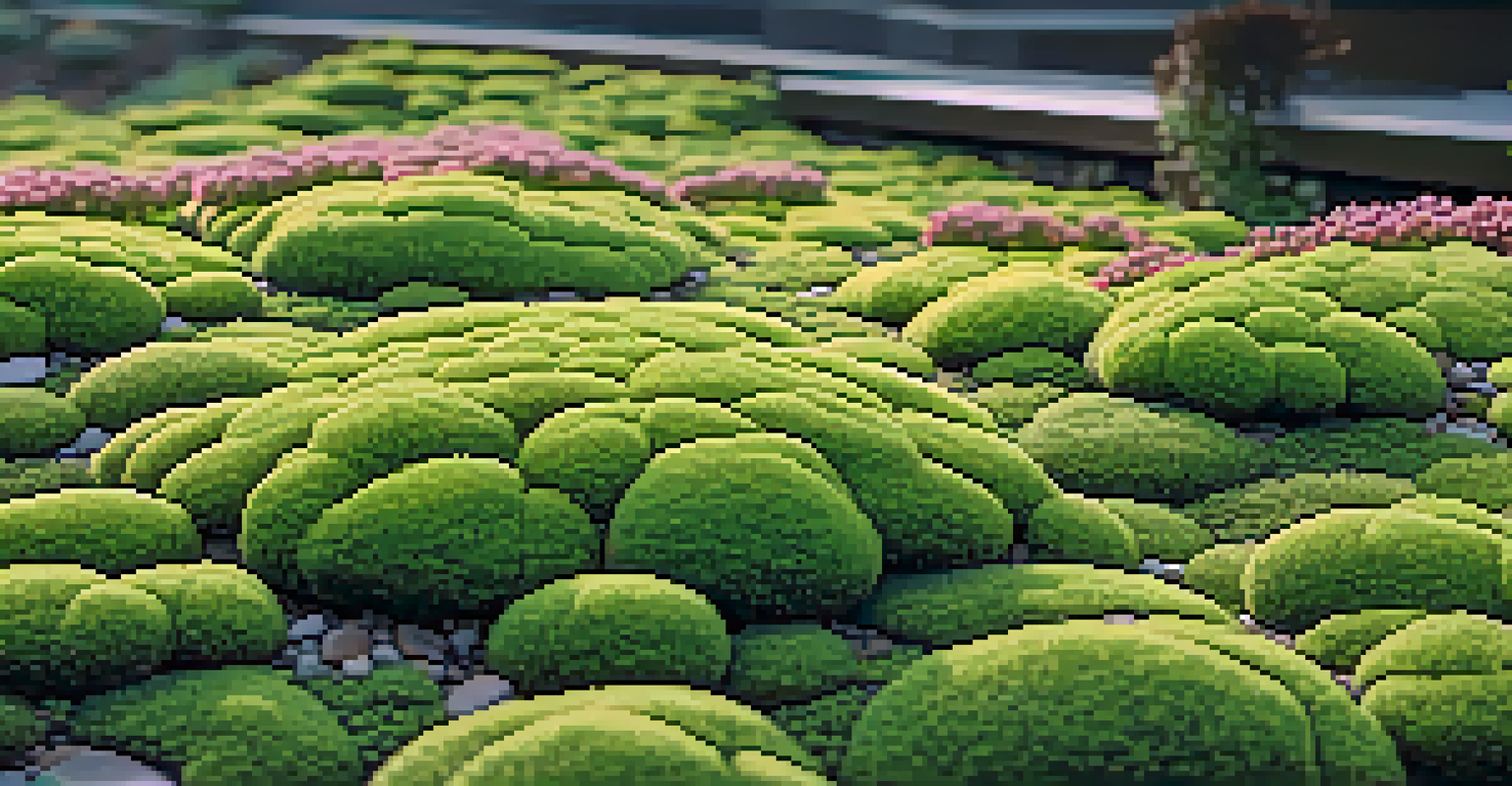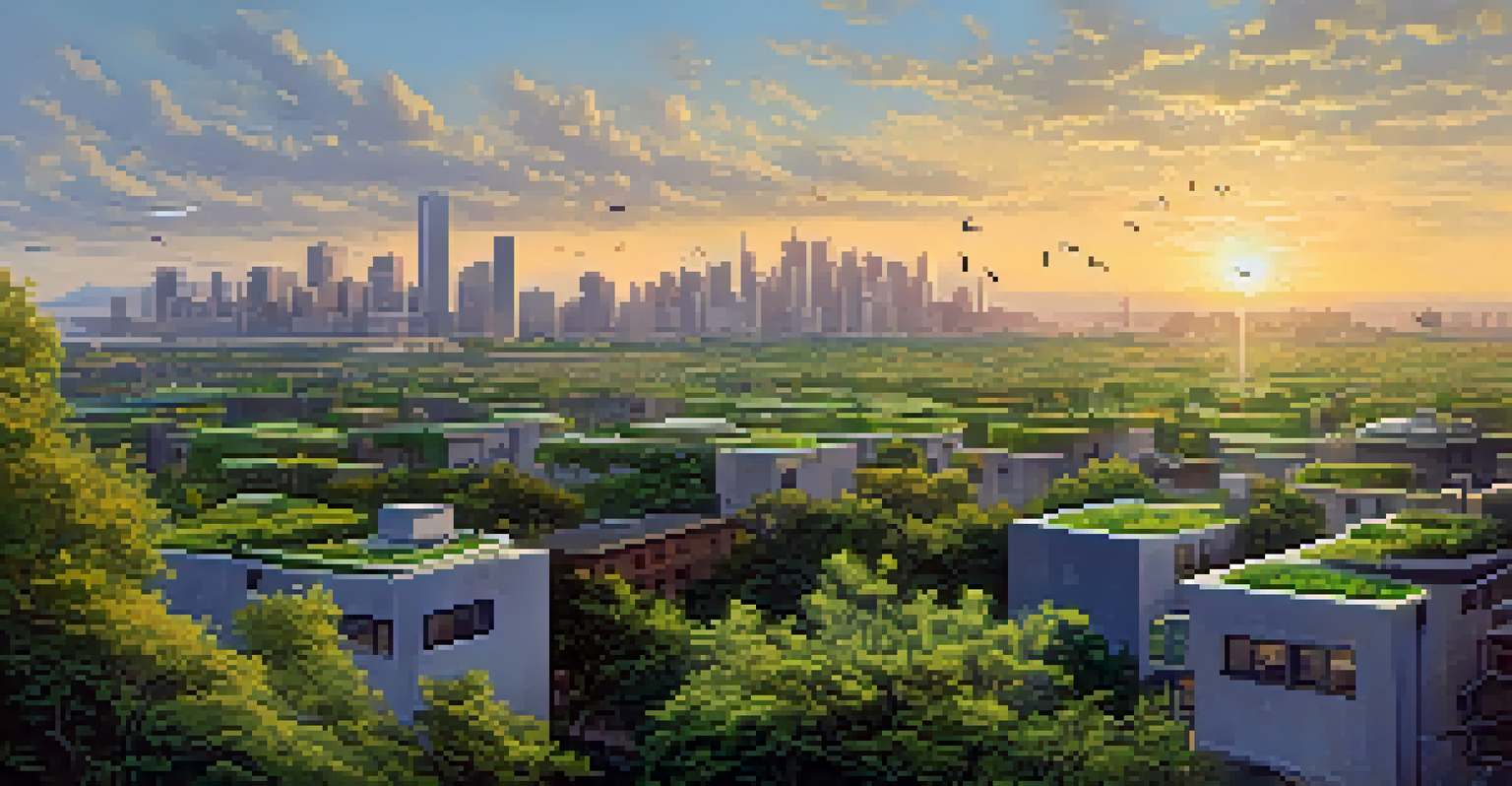The Rise of Green Roofs: Future Trends in Home Design

Understanding Green Roofs: What Are They?
Green roofs, also known as living roofs, are systems that support the growth of vegetation on building rooftops. They can range from simple sedum plants to elaborate gardens, depending on the design and intended use. These roofs not only provide aesthetic appeal but also contribute to environmental benefits, such as improved air quality and heat insulation.
The greening of roofs is an important step in addressing climate change and creating resilient cities.
By incorporating layers of soil and plants, green roofs create a mini-ecosystem that can absorb rainwater and support local wildlife. This concept is becoming increasingly popular in urban areas, where green spaces are limited. As cities grow, the integration of nature into architecture becomes essential for enhancing urban livability.
In essence, green roofs transform otherwise unused spaces into vibrant areas that promote biodiversity. They serve as a reminder that even in densely populated environments, we can cultivate a connection to nature.
Benefits of Green Roofs: More Than Just Aesthetic Appeal
The benefits of green roofs extend far beyond their visual charm. They play a crucial role in reducing urban heat islands—areas that are significantly warmer than their rural surroundings due to human activities. By providing natural insulation, green roofs can lower energy costs associated with heating and cooling.

Moreover, green roofs help manage stormwater runoff effectively, acting as sponges that absorb rainwater and release it slowly. This capability can mitigate flooding and reduce the burden on urban drainage systems. Additionally, they filter pollutants and carbon dioxide from the air, enhancing overall air quality.
Green Roofs Boost Urban Biodiversity
Green roofs transform unused spaces into ecosystems that support local wildlife and improve urban livability.
Incorporating green roofs in home design also promotes well-being. Studies suggest that having access to green spaces can reduce stress and improve mental health, making them not just an environmental asset, but a personal sanctuary for homeowners.
Future Trends: How Green Roofs Are Shaping Home Design
As climate change continues to influence architectural practices, green roofs are becoming a staple in sustainable home design. Architects and builders are increasingly incorporating them into new projects, recognizing their potential to enhance energy efficiency and reduce environmental impact. This trend is likely to grow as more homeowners seek eco-friendly solutions.
Green roofs are not just a trend; they represent a fundamental shift in how we think about urban space and its relationship with nature.
Innovative technologies are also emerging, enabling the creation of more sophisticated green roof systems. From smart irrigation systems that optimize water use to lightweight materials that reduce structural load, these advancements make green roofs more accessible and practical for a variety of homes. The future of home design is undoubtedly leaning towards smarter, greener solutions.
Moreover, local governments are incentivizing green roofs through grants and tax credits, making them an attractive option for homeowners. As awareness grows, the integration of green roofs will likely become a hallmark of modern, sustainable architecture.
Types of Green Roofs: Choosing the Right Option for Your Home
When considering a green roof, it's essential to understand the different types available. Extensive green roofs are generally lighter and require less maintenance, featuring low-growing plants like sedums. They are perfect for homeowners looking for a simple and cost-effective way to introduce greenery to their rooftops.
On the other hand, intensive green roofs are more complex and can support a wider variety of plants, including shrubs and even small trees. These systems require more maintenance and structural support but offer greater aesthetic flexibility and ecological benefits. Choosing the right type depends on your preferences, budget, and the building's structure.
Economic Benefits of Green Roofs
Investing in green roofs increases property value and reduces utility costs, making them a smart choice for homeowners.
Ultimately, the choice between extensive and intensive green roofs will impact not only the appearance of your home but also its environmental footprint. Assessing your needs and consulting with professionals can ensure you select the best option for your unique situation.
Installation and Maintenance: Key Considerations for Homeowners
Installing a green roof involves careful planning and expertise. It's crucial to work with professionals who understand the specific requirements, such as waterproofing and drainage. A poorly installed green roof can lead to leaks and structural damage, so choosing the right team is essential for the longevity of your investment.
Maintenance is another critical aspect to consider. While extensive green roofs generally require less upkeep, they still need periodic checks to ensure plants remain healthy and the drainage systems function properly. Intensive roofs demand more attention, including regular watering, fertilization, and plant replacement.
By understanding these factors, homeowners can enjoy the benefits of a green roof without the stress of unforeseen complications. A well-planned installation paired with regular maintenance can lead to a flourishing green space that enhances both the home and the environment.
The Economic Impact of Green Roofs: Adding Value to Properties
Investing in a green roof can significantly increase a property's value. Potential buyers are often attracted to homes with energy-efficient features and sustainable practices, making green roofs a smart selling point. In today’s market, where eco-conscious living is becoming the norm, homes with green roofs can stand out from the competition.
Beyond resale value, green roofs also reduce operational costs. Homeowners can save on heating and cooling expenses due to improved insulation. Additionally, some regions offer financial incentives for green roof installations, offsetting initial costs and enhancing the return on investment.
Green Roofs: A Trend in Home Design
As sustainability becomes a priority, green roofs are increasingly integrated into modern architecture for energy efficiency.
Thus, the economic impact of green roofs is twofold: they enhance property value while simultaneously lowering utility bills. This balance makes green roofs an appealing choice for environmentally minded homeowners.
Cultural Shifts: The Growing Acceptance of Green Roofs
As awareness of environmental issues grows, so does the acceptance of green roofs in mainstream architecture. Communities across the globe are embracing these sustainable practices, leading to cultural shifts in how we view urban living. Green roofs are no longer seen as niche projects but as vital components of modern home design.
This cultural change is reflected in various initiatives, such as urban planning policies that promote green infrastructure. Cities are beginning to recognize the importance of integrating nature into urban environments, enhancing overall quality of life. The presence of green roofs contributes to a sense of community and connection to nature.

In a world where environmental concerns are increasingly pressing, the rise of green roofs signifies a hopeful trend towards more sustainable living. As we collectively shift our mindset, the future of home design looks greener than ever.